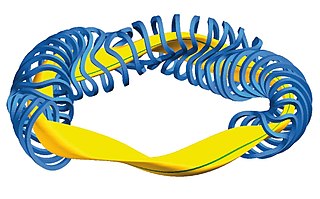
A stellarator is a plasma device that relies primarily on external magnets to confine a plasma. Scientists researching magnetic confinement fusion aim to use stellarator devices as a vessel for nuclear fusion reactions. The name refers to the possibility of harnessing the power source of the stars, such as the Sun. It is one of the earliest fusion power devices, along with the z-pinch and magnetic mirror.
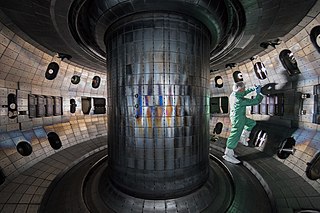
A tokamak is a device which uses a powerful magnetic field to confine plasma in the shape of a torus. The tokamak is one of several types of magnetic confinement devices being developed to produce controlled thermonuclear fusion power. As of 2016, it was the leading candidate for a practical fusion reactor. The word "tokamak" is derived from a Russian acronym meaning "toroidal chamber with magnetic coils".
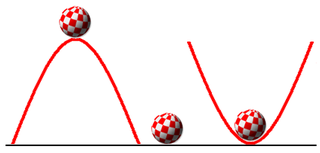
The stability of a plasma is an important consideration in the study of plasma physics. When a system containing a plasma is at equilibrium, it is possible for certain parts of the plasma to be disturbed by small perturbative forces acting on it. The stability of the system determines if the perturbations will grow, oscillate, or be damped out.

A reversed-field pinch (RFP) is a device used to produce and contain near-thermonuclear plasmas. It is a toroidal pinch which uses a unique magnetic field configuration as a scheme to magnetically confine a plasma, primarily to study magnetic confinement fusion. Its magnetic geometry is somewhat different from that of the more common tokamak. As one moves out radially, the portion of the magnetic field pointing toroidally reverses its direction, giving rise to the term reversed field. This configuration can be sustained with comparatively lower fields than that of a tokamak of similar power density. One of the disadvantages of this configuration is that it tends to be more susceptible to non-linear effects and turbulence. This makes it a useful system for studying non-ideal (resistive) magnetohydrodynamics. RFPs are also used in studying astrophysical plasmas, which share many common features.
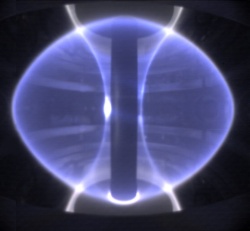
Magnetic confinement fusion (MCF) is an approach to generate thermonuclear fusion power that uses magnetic fields to confine fusion fuel in the form of a plasma. Magnetic confinement is one of two major branches of controlled fusion research, along with inertial confinement fusion.

A spheromak is an arrangement of plasma formed into a toroidal shape similar to a smoke ring. The spheromak contains large internal electric currents and their associated magnetic fields arranged so the magnetohydrodynamic forces within the spheromak are nearly balanced, resulting in long-lived (microsecond) confinement times without external fields. Spheromaks belong to a type of plasma configuration referred to as the compact toroids. A spheromak can be made and sustained using magnetic flux injection, leading to a dynomak.
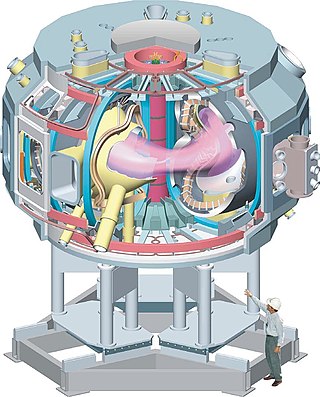
The National Compact Stellarator Experiment, NCSX in short, was a magnetic fusion energy experiment based on the stellarator design being constructed at the Princeton Plasma Physics Laboratory (PPPL).
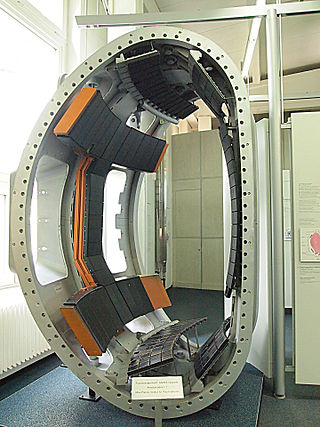
ASDEX Upgrade is a divertor tokamak at the Max-Planck-Institut für Plasmaphysik, Garching that went into operation in 1991. At present, it is Germany's second largest fusion experiment after stellarator Wendelstein 7-X.

The Helically Symmetric Experiment, is an experimental plasma confinement device at the University of Wisconsin–Madison, with design principles that are intended to be incorporated into a fusion reactor. The HSX is a modular coil stellarator which is a toroid-shaped pressure vessel with external electromagnets which generate a magnetic field for the purpose of containing a plasma. It began operation in 1999.
Trisops was an experimental machine for the study of magnetic confinement of plasmas with the ultimate goal of producing fusion power. The configuration was a variation of a compact toroid, a toroidal (doughnut-shaped) structure of plasma and magnetic fields with no coils penetrating the center. It lost funding in its original form in 1978.

A spherical tokamak is a type of fusion power device based on the tokamak principle. It is notable for its very narrow profile, or aspect ratio. A traditional tokamak has a toroidal confinement area that gives it an overall shape similar to a donut, complete with a large hole in the middle. The spherical tokamak reduces the size of the hole as much as possible, resulting in a plasma shape that is almost spherical, often compared to a cored apple. The spherical tokamak is sometimes referred to as a spherical torus and often shortened to ST.
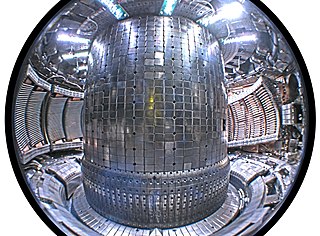
In magnetic confinement fusion, a divertor or diverted configuration is a magnetic field configuration of a tokamak or a stellarator which separates the confined plasma from the material surface of the device. The plasma particles which diffuse across the boundary of the confined region are diverted by the open, wall-intersecting magnetic field lines to wall structures which are called the divertor targets, usually remote from the confined plasma. The magnetic divertor extracts heat and ash produced by the fusion reaction, minimizes plasma contamination, and protects the surrounding walls from thermal and neutronic loads.

The Hybrid Illinois Device for Research and Applications (HIDRA) is a medium-sized toroidal magnetic fusion device housed in the Nuclear Radiation Laboratory and operated by the Center for Plasma-Material Interactions (CPMI) within the Department of Nuclear, Plasma and Radiological Engineering at the University of Illinois at Urbana–Champaign, United States. HIDRA had its first plasma at the end of April 2016 and started experimental campaigns by December of that year. HIDRA is the former WEGA classical stellarator that was operated at the Max Planck Institute for Plasma Physics in Greifswald Germany from 2001 to 2013.

TJ-II is a flexible Heliac installed at Spain's National Fusion Laboratory.
The interchange instability, also known as the Kruskal–Schwarzchild instability or flute instability, is a type of plasma instability seen in magnetic fusion energy that is driven by the gradients in the magnetic pressure in areas where the confining magnetic field is curved.

The Compact Toroidal Hybrid (CTH) is an experimental device at Auburn University that uses magnetic fields to confine high-temperature plasmas. CTH is a torsatron type of stellarator with an external, continuously wound helical coil that generates the bulk of the magnetic field for containing a plasma.
Jürgen Nührenberg is a German plasma physicist.
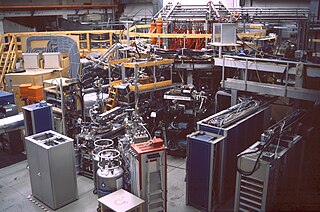
Wendelstein 7-AS was an experimental stellarator which was in operation from 1988 to 2002 by the Max Planck Institute for Plasma Physics (IPP) in Garching. It was the first of a new class of advanced stellarators with modular coils, designed with the goal of developing a nuclear fusion reactor to generate electricity.

Omnigeneity is a property of a magnetic field inside a magnetic confinement fusion reactor. Such a magnetic field is called omnigenous if the path a single particle takes does not drift radially inwards or outwards on average. A particle is then confined to stay on a flux surface. All tokamaks are exactly omnigenous by virtue of their axisymmetry, and conversely an unoptimized stellarator is generally not omnigenous.

In magnetic confinement fusion, a flux surface is a surface on which magnetic field lines lie. Since the magnetic field is divergence-free, the Poincare-Hopf theorem implies that such a surface must be either a torus, or a knot. In the tokamak and the stellarator flux surfaces have toroidal shapes, whereas the more exotic knotatron has a knotted flux surface. Flux surfaces are typically characterized by the poloidal magnetic flux or the toroidal magnetic flux. The poloidal flux is the magnetic flux passing through a ribbon going from the magnetic axis to the flux surface, and the toroidal flux is the magnetic flux passing through a circle which encloses the magnetic axis. The total flux passing through flux surface itself is zero, as magnetic field lines are everywhere tangent to the surface.



















